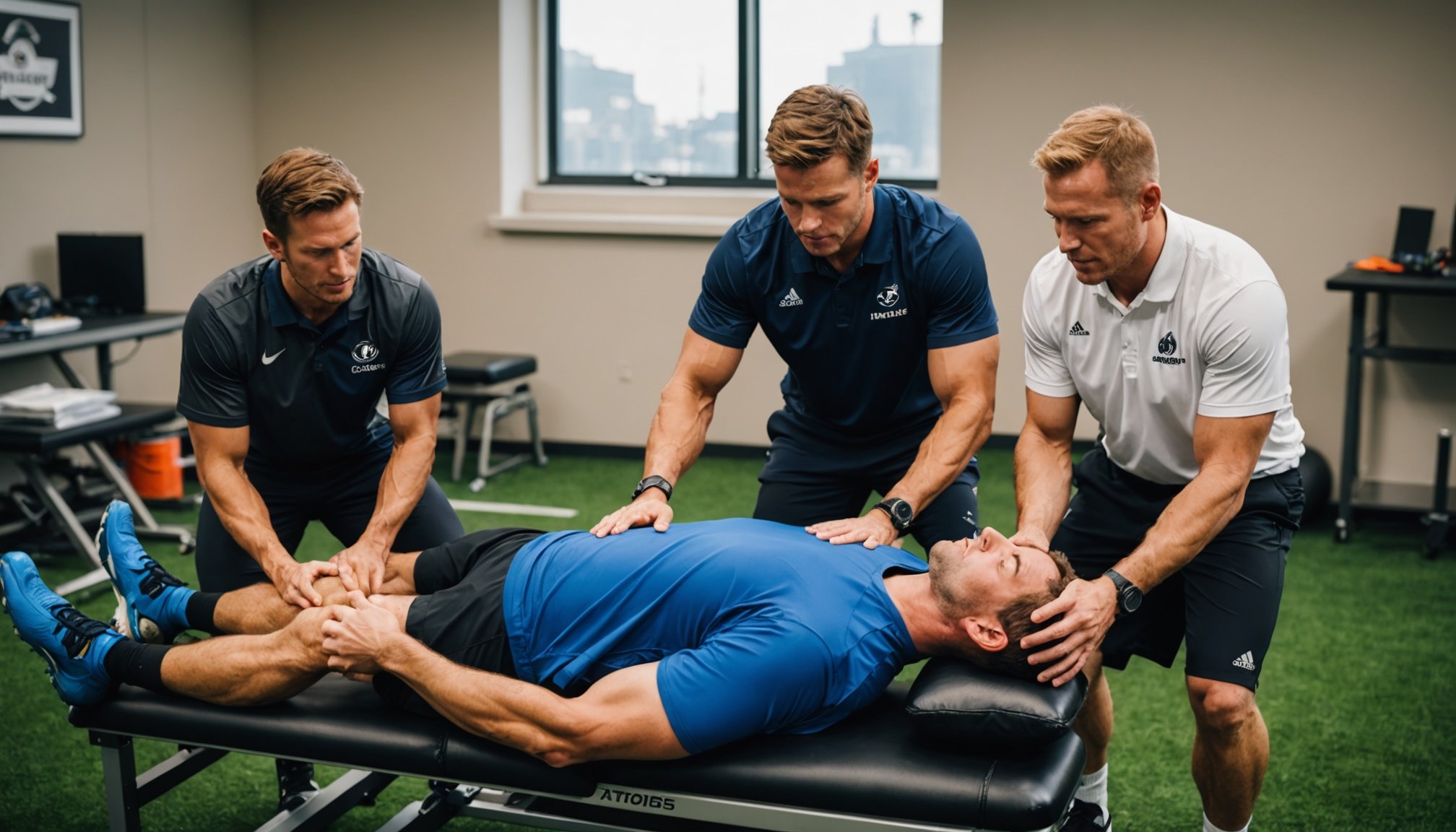The Importance of Interdisciplinary Collaboration in Athlete Recovery
In the realm of athlete recovery, interdisciplinary teams prove indispensable for enhanced rehabilitation. A harmonious synergy among various sports medicine professionals encompasses a comprehensive recovery strategy. This collaboration integrates diverse perspectives and expertise, ultimately expediting the recovery speed and improving outcomes for athletes.
Interdisciplinary teams in sports medicine bring together a myriad of specialisations including physiotherapists, nutritionists, sports psychologists, and coaches. The benefits of such teamwork are multifaceted. Different professionals offer distinct insights and approaches, crafting a holistic pathway to recovery. By fostering open communication and collective problem-solving, these teams devise customised rehabilitation plans tailored to each athlete’s needs.
Have you seen this : Enhancing formula 1 reaction times: unleashing the power of non-invasive brain stimulation
The impact on recovery is substantial. Athletes experience not only quicker rehabilitation due to the comprehensive care but also reduced risks of re-injury. Each professional contributes uniquely: physiotherapists focus on physical healing, nutritionists ensure optimal dietary support, while psychotherapists and coaches motivate and guide athletes psychologically.
Hence, the concerted efforts of interdisciplinary teams are essential in the realm of sports rehabilitation, cultivating a nurturing environment that significantly bolsters an athlete’s journey back to peak performance.
In parallel : Unleashing potential: how multi-sport participation enhances children”s motor skill development
Roles of Key Professionals in Injury Rehabilitation
Within injury rehabilitation, the roles of professionals such as physiotherapists, nutritionists, and coaches, are critical to an athlete’s successful recovery. Each professional brings vital expertise that contributes to a holistic rehabilitation process.
Physiotherapists’ Contributions
Physiotherapists play a significant role, using specialized methods to assess injuries and tailor recovery plans. They design and implement specific rehabilitation exercises and treatments. This personalized approach ensures that each athlete’s unique needs are addressed, leading to more efficient recovery.
The Role of Nutritionists
Nutritionists are pivotal in focusing on the importance of diet in recovery and overall performance. They provide specific dietary recommendations for injured athletes to promote healing and optimise physical well-being. Their guidance ensures the athlete receives the correct nutrients, aiding effective rehabilitation.
Coaches’ Involvement in Recovery
Coaches play an essential role by communicating recovery plans to athletes. They offer psychological support and motivation, which are crucial during rehabilitation. By keeping athletes focused on their recovery goals, coaches help maintain mental resilience, further enhancing the effectiveness of rehabilitation efforts.
Innovative Techniques and Technologies in Rehabilitation
In the evolving field of rehabilitation, incorporating innovative techniques and technologies enhances athlete recovery. Advanced rehabilitation technologies such as telehealth and remote monitoring revolutionise recovery by enabling athletes to engage with healthcare professionals remotely. This approach provides continuous monitoring and feedback, safeguarding athletes’ consistency with their rehabilitation plans.
The use of modern approaches allows practitioners to leverage cutting-edge equipment for injury treatment. Devices like anti-gravity treadmills and cryotherapy chambers introduce new dimensions in enhancing healing processes. These tools are essential in tailoring recovery regimens that address each athlete’s needs distinctively.
Case studies further validate the successful application of these technologies. For instance, in scenarios where athletes benefited from remote consultations and shared real-time data, faster recovery and minimised setbacks were observed. These successes underscore the importance of embracing modern strategies to optimise rehabilitation outcomes.
Moreover, the adoption of such innovative techniques fosters efficient and effective recovery, positioning athletes for a smoother return to their peak performance. It is vital for professionals in sports medicine to stay abreast of upcoming technological advancements, ensuring the continual enhancement of athlete recovery strategies.
Case Studies Illustrating Effective Collaboration
In the field of sports rehabilitation, detailed case studies showcase the profound success of interdisciplinary teams. These studies illustrate how collaborative recovery protocols significantly enhance the rehabilitation process for athletes. Through real-life scenarios, the power of diverse expertise merging into a cohesive strategy becomes evident.
In one such case, a famous tennis player’s swift return from injury was attributed to the adept coordination among physiotherapists, nutritionists, and coaches. The team crafted an innovative blend of techniques. Physiotherapists prioritised customised exercises; nutritionists recommended healing-focused diets; while coaches provided essential motivation. This harmonious collaboration accelerated the athlete’s recovery speed, allowing a triumphant return to the court.
Testimonials from sports medicine professionals further validate these collaborative successes. Experts underline the critical role of open communication and shared decision-making in crafting effective recovery strategies. These accounts not only highlight successful collaborations but also emphasise the measurable impact on recovery outcomes.
Overall, these case studies cement the importance of collaboration success within sports medicine. By leveraging interdisciplinary approaches, sports rehabilitation continues to evolve, optimising every athlete’s journey back to peak performance.
Measuring the Success of Collaborative Approaches
Understanding the effectiveness of collaborative approaches in athlete recovery requires a firm grasp on recovery outcomes and the use of precise success metrics. By employing statistical analysis, sports medicine professionals can critically assess these outcomes. Key performance indicators, such as recovery time reduction and injury recurrence rates, offer measurable ways to gauge progress. Studies routinely show that athletes undergoing interdisciplinary rehabilitation tend to recover more quickly than those relying on traditional approaches alone.
Detailed research has provided valuable insights, demonstrating that athletes recovering through collaborative care report heightened satisfaction and less emotional stress. The comprehensive support offered by interdisciplinary teams often translates into more positive feedback from the athletes themselves. Furthermore, statistical comparisons indicate that collaborative schemes show not only faster recovery rates but also a decreased likelihood of future injuries.
While traditional methods sometimes overlook the value of diverse professional input, collaborative models prove their worth through marked improvements in recovery statistics. Consequently, statistical analysis solidifies the necessity of teamwork in rehabilitation, validating the multifaceted approach advocated by today’s sports medicine experts. As such, understanding and applying these metrics is crucial for refining and enhancing athlete recovery strategies continually.
Future Directions in Athlete Recovery Techniques
The future of athlete recovery is shaped by evolving innovations and strategies that aim to refine the rehabilitation process. Interdisciplinary teams will see expanded roles as they integrate cutting-edge practices and technologies to enhance recovery outcomes. Anticipating these shifts prepares sports medicine professionals for a landscape where collaborative efforts drive progress.
Emerging Strategies and Technologies
A significant trend involves the incorporation of emerging technologies like wearable sensors and AI-driven analytics. These tools will offer real-time insights into athletes’ performance, enabling tailored interventions. The precision delivered by such technologies will foster more effective and customised rehabilitation plans.
Professionals must stay vigilant to changes in athlete recovery innovations. Ongoing education and collaboration between experts ensure that all team members remain well-informed about new emerging strategies. This vigilance supports adaptability in practice and promotes the integration of novel methodologies.
The importance of ongoing training cannot be overstated. As methods evolve, sports medicine specialists must continuously update their skills to offer athletes the best possible support. By embracing future trends and multidisciplinary approaches, the sports medicine field can enhance recovery techniques, ensuring robust rehabilitation pathways for athletes.







